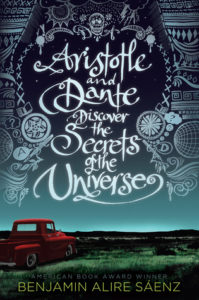
Aristotle and Dante Discover the Secrets of the Universe
Benjamin Alire Sáenz
Simon & Schuster Books for Young Readers
Published February 21, 2012
Amazon | Barnes & Noble | Book Depository | Indiebound | Goodreads
About Aristotle and Dante Discover the Secrets of the Universe
Aristotle is an angry teen with a brother in prison. Dante is a know-it-all who has an unusual way of looking at the world. When the two meet at the swimming pool, they seem to have nothing in common. But as the loners start spending time together, they discover that they share a special friendship—the kind that changes lives and lasts a lifetime. And it is through this friendship that Ari and Dante will learn the most important truths about themselves and the kind of people they want to be.
My Review
I’ve wanted to read this book for a long time, and I’m glad I finally did it! I liked Ari right from the beginning. He’s a loner, both content to be alone and also miserable about it. He has an interesting relationship with his family, particularly both of his parents. I love that his dad and his relationship with his dad plays such a key role in the story. It’s not a major focus at all, but there are like these microburst moments between them that change everything.
I also love Ari’s relationship with Dante. They’re a perfect foil for each other. Dante is this upbeat, optimistic chatterbox, where Ari is a quiet, brooding guy who processes everything inside his head. Emotions are Dante’s first language, but they remain mysterious and opaque to Ari.
ARISTOTLE AND DANTE is a relationships book. The plot is kind of winding and I felt like it stalled out briefly in a few places. But the relationships with the characters, even between Ari and peripheral characters, remain dynamic and compelling. I’m so glad I read this book.
Content Notes
Recommended for Ages 14 up.
Representation
Both Ari and Dante’s families are Mexican.
Profanity/Crude Language Content
Extreme profanity used fairly frequently.
Romance/Sexual Content
Kissing between boy and girl and two boys.
Spiritual Content
None.
Violent Content
References to a boy getting beat up by several other boys. One scene shows a boy beating up another.
Drug Content
Several scenes show teens drinking alcohol. There are references to smoking pot and doing heroin, and one scene that shows two characters smoking pot.
Note: This post contains affiliate links, which do not cost you anything to use, but which help support the costs of running this blog.